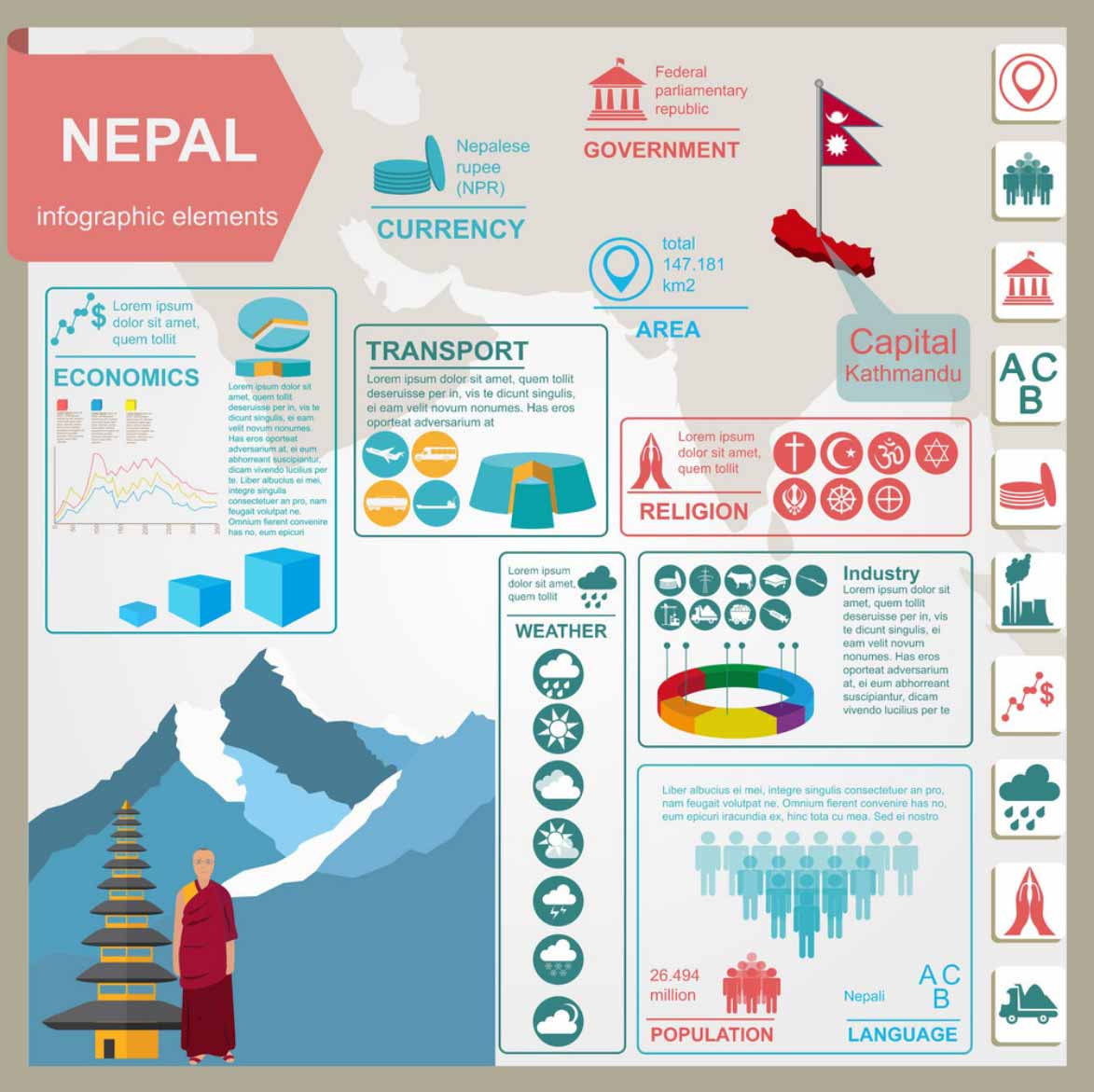Nepal: A Data Overview
A comprehensive data journal with an objective to
make data free for everyone collected and
compiled in one single address. Explore with us.
Nepal in Data

GEOGRAPHY
Situated in southern flank of the Himalayas, Nepal is a landlocked country, enclosed between the Tibetan plateau and the Gangetic plains in the Central Himalayas. Geographically it lies between 800 4′ & 880 12′ East longitude and 260 22′ & 300 27′ North latitude. It is roughly rectangular in shape and has an area of 147,641.71 sq.km. (corrected recently by developing new map of Nepal from 147,181 sq. Km), extending roughly 885 km from East to West and varies from 145-241 km North-South. Out of the total area, 4,000 sq. Km is covered by water. The country is bordered by India in the east, west and south (1,930 km) while big mountains towards China segregate the north side (1,497 km). Altitude in Nepal varies from 67m above sea level at Kechana Kalan (Jhapa) in southeastern Terai to Mt. Sagarmatha 8,848 m, the highest peak in the world located at Solukhumbu in north eastern Himalayas.
Topographically, the country can be divided into four main regions starting from the North, viz. 1) The Himalayan Region and Inner Himalayas (altitude ranging 16,000 to 29,028 ft. (4878 to 8848 meters) perpetually covered with snow, 2) The Sub-Himalayas or the mountainous region (altitude ranging 6000 to 16,000 ft. (1,828 to 4,876 meters), 3) The valley basin, Dun or Inner Terai (altitude ranging 900 to 2,000 ft. (274 to 609 meters), and 4) The Low plain region – Terai (altitude ranging 300 to 900 ft. (91 to 274 meters). But for all practical purposes, the country is divided in to three broad ecological zones:
- The Mountain region, comprising 35.2% of the country’s land surface, is sparsely inhabited. The highest peaks of the Himalayas like Sagaramatha (29028ft. /8848m), Kanchanjunga (28,208 ft./8,586m), Lhotse (27,809 ft./ 8,516m) lie along the northern border.
- The Hill region comprises 41.7% of Nepal’s land area. The Mahabharat range forms this region. To the south of it lies the Churia range. The two ranges enclose between them valleys of various widths and altitudes, known as Duns or the inner Terai. Some of the valleys in this region are Kathmandu, Pokhara and Surkhet.
- The Terai comprises 23.1% of the total land area. It has a width ranging from 16 miles (25.6km) to 20 miles (32km). The terai zone ranges in altitude of less than 610 meters with most of the fertile land and dense forest the country.
Apart from the ecological divisions, administratively there are 7 Provinces, 77 Districts and 753 local governments. Local government is composed of 6 metropolitan cities, 11 sub-metropolitan cities, 276 municipalities, 460 sub-municipalities and 6743 wards.
The geographical features of Nepal not only manifest the diversity but also reflect distinctive patterns of settlements, population distribution, culture and economy. Out of total land area Terai comprises only 23.1 percent, whereas the share of Mountain is 41.7 percent and Hill is 35.2 percent respectively.
Nepal has many high, beautiful and attractive mountains, out of thirty one mountain peaks over 7,600 meters in the world, twenty two lie in Nepal. Further, among the fourteen snow-topped mountains over 8,000 meters in the world, eight are located in Nepal with the highest peak Sagarmatha (Everest) 8,848 meters situated in the region.
Climate
Nepal has extreme climatic variations, which is associated with the diverse nature of its topography and altitude and pronounced by dry and wet monsoon seasons. Average rainfall of between 1,400 and 2,500 mm annually predominate over most of the central Himalayan region. The percentage of annual rainfall brought by the monsoon between June and September is higher in Terai (81%) and eastern and central hills (79%) than in the western hills (67%) and in the Trans Himalayas (55%). In Terai and eastern/central hills, winters are very dry (2.4%), and the remaining rain occurs in spring (11%) and autumn (7.7%). (Shah and Singh, 2001)
Climatically, Nepal may be divided into three types
Subtropical: The Terai, the Inner Terai and lower foothills gave a sub-tropical climate. The temperature ranges from 5° c to 47° c. Rainfall in this area is between 80″ and 100″ (2000mm and 2500mm).
Temperate: The area between the Mahabharat range and Himalayas has a temperate climate, the temperature varies between 0° C and 30° C. Average rainfall is about 60″ (1500mm).
Alpine: The Himalayas and Inner Himalayas have an Alpine, Dry & Arid type of climate. The temperature is several degrees below zero during winter and never above 16° c during summer. The average rainfall is 20″ (500mms) and in the higher regions precipitation is in the form of snow.
Social and Cultural Diversity
Nepal is inhabited by multi-lingual people, there are 123 spoken languages and 125 ethnic/caste groups.With majority of population speaking Nepali (44.6%) as their mother toungue, there are many other linguistic groups like Maithili, Bhojpuri, Newari, Tharu, Tamang, Rai, Magar, etc. Ethnically the largest group is Chettri (16.6%) followed by Hilll Brahmins (12.2%), Magars (7.12%), Tharus (6.56%), Tamangs (5.81%) etc. In terms of religion, Hindu (81.3%) is predominant followed by Buddism and Islam.
Nepalese culture linked to various ethnic and social values are remarkably rich and fascinating. One of the specific features of Nepalese culture is religious harmony between the Hindu and the Buddhist. Although there is diversity in religion, ethnicity, language, customs, life-style, traditions, folklore of people there is always unity in culture. Festivals are a prominent aspect of Nepalese life style and different types of festivals are observed throughout the year. Most of the Nepalese festivals are of religious as well as of social values and either of the Hindu and Buddhist origin is celebrated in common by the people with enthusiasm.
Country Overview
| Indicator | Value |
|---|---|
| Geography | |
| Area (sq.km) | 148603.97 |
| Capital | Kathmandu |
| Administrative Division | |
| Districts | 77 |
| Metropolitan City | 6 |
| Sub-Metropolitan City | 11 |
| Municipality | 276 |
| Gaun Palika | 460 |
| Total No. of Wards | 6743 |
| Voters (Baishakh 2079) | |
| Total | 17733723 |
| Male | 8992010 |
| Female | 8741530 |
| TG | 183 |
| Constituenties | 165 |
| Demography | |
| Population (2021) | 29192480 |
| Male | 14291311 |
| Female | 14901169 |
| Sex Ratio (M/F) | 95.91 |
| Total Household | 6761059 |
| Average Household Size | 4.32 |
| Population Density (persons/sq.km) | 198 |
| Population by Type of Local Unit | |
| Metropolitan City | 2399457 |
| Sub-Metropolitan City | 1556513 |
| Municipality | 12558330 |
| Gaun Palika | 9730528 |
| note: percentage as of total population of the province | |
| Under 14 Population (%) | 0.349 |
| Population 15-59 yrs (%) | 0.57 |
| Elderly Population 60+ (%) | 0.081 |
| Annual Growth Rate (%) | 0.0135 |
| Household by Ownership of House (2011) | |
| Own | 4623653 |
| Rented | 694701 |
| Household using wood/firewood as type of cooking fuel | 3470224 |
| Household using Electricity as type of cooking fuel | 131596 |
| Household with access to safe drinking water* | 2591379 |
| Household with access to Toilet Facilities | 3318514 |
| Household without access to Toilet Facilities | 2069812 |
| Household with access to Internet | 180746 |
| Household with access to Mobile Phone | 3504929 |
| Household with access to Radio | 2756325 |
| Household with access to Television | 1976603 |
| Household with access to Electricity for lighting | 3647746 |
| Household by Type of Foundation of House | |
| Household with Mud bonded bricks/stone as foundation of house | 2397441 |
| Household with Cement bonded bricks/ stone as type of foundation of house | 952702 |
| RCC with pillar | 539004 |
| Wooden pillar | 1350151 |
| Household with Female ownership in | |
| Both house & land | 580757 |
| Land only | 488314 |
| Neither house nor land | 4310560 |
| Socio-Economic Indicators | |
| Literacy (%) (NMICS 2019) | |
| Total | 90.3 |
| Male | 88.2 |
| Female | 92.7 |
| Number of Schools (Public) 2018/19 | |
| L_Basic | 28660 |
| U_Basic | 11664 |
| Basic | 28811 |
| Secondary | 6623 |
| Higher Secondary | 3005 |
| Number of Schools (Private) | |
| L_Basic | 6007 |
| U_Basic | 4401 |
| Basic | 6030 |
| Secondary | 3362 |
| Higher Secondary | 866 |
| Number of Students (Public) | |
| L_Basic | 2793142 |
| U_Basic | 1393617 |
| Basic | |
| Secondary | 808577 |
| Higher Secondary | 555739 |
| Number of Students (Private) | |
| L_Basic | 937460 |
| U_Basic | 431160 |
| Basic | |
| Secondary | 218935 |
| Higher Secondary | 75797 |
| NER 2018/19 | |
| L-Basic | |
| U_Basic | |
| Basic | |
| Secondary | |
| Higher Secondary | |
| Agriculture (FY 017/18) | |
| Production of Major Cereal Crops (MT)2017/18 | |
| Paddy | 5151925 |
| Maize | 2596841 |
| Wheat | 1973151 |
| Production of Major Cash Crops (MT) 2017/18 | 0 |
| Oil Seed | 245867 |
| Potato | 2881829 |
| Sugarcane | 3679508 |
| Production of Pulses | 368740 |
| Production of Spices | 474349 |
| Production of Vegetables (MT) | 3958230 |
| Productio of Milk (MT) | 2092403 |
| Production Eggs in number (000) | 1511483 |
| Production of Fish (Kg) | 58443292 |
| Meat Production (MT) | 346179 |
| Production of Wool (MT) | 594639 |
| Production of Fruits (MT) | |
| Citrus Fruits# | 245176 |
| Winter Fruits** | 108315 |
| Summer Fruits*** | 733439 |
| Annual Sales of Chemical Fertilizers (017/18) | 364020.07 |
| Health Service**** | |
| Number of Hospitals | 122 |
| Primary health care center (PHCC) | 200 |
| Health Care Centers | 3809 |
| Female Health Care Volunteer | 49001 |
| Road Connectivity | |
| Total Road Length## (Km) | 13447.61 |
| Population Influenced per Km of Road | 151655 |
| Road Density (Km/100 sq.km) | 995 |
Federal Parliament
The constitution of Nepal, adopted in 2015, envisions bicameral legislature. According to the Article 83 of the Constitution, the House of Representatives (also known as lower house) and the National Assembly (also known as Upper house) are named as Federal Parliament. Of the total 334 members in the Federal Parliament, there are 112 women members i.e. 33.53%.
According to constitution, Lower house of the federal parliament has altogether 275 members among which 165 members (i.e. 60% of the total members) are elected through the first past the post (FPTP) electoral system and remaining 110 members (i.e. 40% of the total members) through the proportional representation (PR) electoral system. The term of this House is for Five years.
Nepal’s constitution Part-5 Structure of State and Distribution of State Power 56 states that there shall be States consisting of the Districts as mentioned in Schedule-4 existing in Nepal at the time of commencement of this Constitution. And (4) There shall be Village Institutions, Municipalities and District Assemblies under the Local level. The number of Wards in a Village Institution and Municipality shall be as provided for in the Federal law.
Local Government by Province
| wdt_ID | Province | Districts | Metropolitan Cities | Sub Metropolitan Cities | Municipalities | Rural Municipalities | Wards |
|---|
Human Development
Nepal’s national HDI score stood at 0.587 in 2019, which puts the country in the medium human development category. Its score in urban areas (0.647) surpasses that of rural areas (0.561) with a large urban-rural gap. Higher per capita income, and better access to education and health services in urban areas explain such striking disparities. The HDI value also varies across provinces. As expected, Bagmati province scores the highest (0.66), followed by Gandaki province (0.62). Province 2 scores the lowest (0.51) followed by Karnali (0.538). This indicates the uneven distribution of development outcomes across different parts of the country. Among the ecological regions, areas defined as the hills continue to surpass mountain areas and the Tarai, a pattern similar to findings in previous Nepal Human Development Reports regardless of methodological differences. Contrary to the common perception that people in the mountains are poorer than those in the Tarai, these two regions score at the same level on the HDI (0.56) and lag behind the hills.
Provinces in Data
Province 1
Lumbini Province
Province 2
Karnali Province
Bagmati Province
Sudurpaschim
Province
Gandaki Province
Districts
in Data
Human Development Index 2019
Life Expectancy at Birth (years)
Gender Inequality Index
Percapita GDP in (US $)
Percapita GNI (US $)
Sector-wise Data Overview of Nepal
Fast Facts of Nepal
Nepal Outlook compiles key indicators based upon recently updated research and survey documents published and endorsed by Central Bureau of Statistics, Nepal Government in a most easiest and clear format.
We also help you get any data, report and research materials upon request at a minimum service charge.
18.7%
Population Below Poverty Line
77.2%
Skilled Attendant in Delivery
55.8%
Household Receive Remittance
46.7%
Contraceptive Prevalence Rate
42133
Hydro-power Potential (MW)
11.4%
Unemployment
Rate
90.3%
Literacy Rate (NMICS 2019)
4792096
Foreign Employment
89.9%
Popn with Access to Electricity
13448
Total SRN
Road (km)
51.1%
Household with Internet Facility
1980
Popn Influenced per Km of Road
Data Leader, 21 Years in a Row
Focusing on various sectors related to development of the country, our team has been actively involved in disseminating information about districts since 1999 AD through various editions of Data Profile’s namely District Development Profile of Nepal (2001), District Demographic Profile of Nepal (2002), District Development Profile of Nepal (2004), National Policies of Nepal, Development Profile of Nepal (2008) & Energy Outlook of Nepal (2011).


The Right Choice
Share us your contact details to discuss on how we can work together on your research and study projects. We come and discuss your problem statements and provide expert consulting to derive right process and solution for your business.
